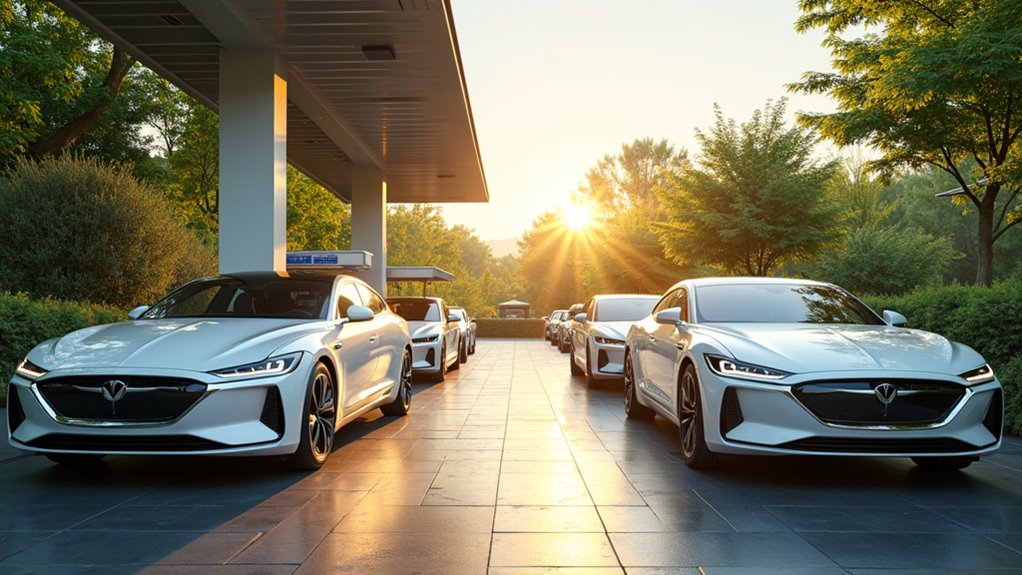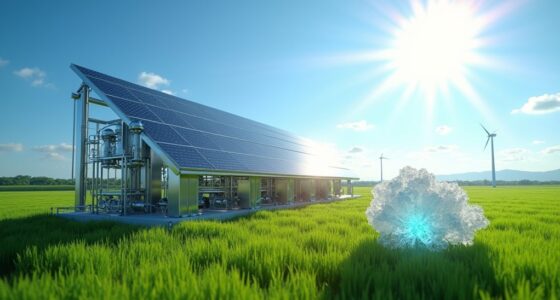In a green economy, fuel cells offer higher efficiency (40-60%) and produce only water vapor, making them ideal for long-distance and urban use. Combustion engines are less efficient (20-30%) and emit some pollutants but benefit from existing infrastructure. Fuel cells support sustainability and eco-friendly operations, while combustion engines serve as interim solutions. To discover how these technologies differ in performance and impact, keep exploring the key factors shaping a sustainable hydrogen future.
Key Takeaways
- Fuel cells offer higher efficiency (40-60%) and produce only water vapor, supporting sustainable, low-emission transportation in a green economy.
- Combustion engines are more tolerant of hydrogen impurities and utilize existing infrastructure, providing a transitional, cost-effective solution.
- Hydrogen fuel cells are ideal for long-distance and heavy-duty applications due to their higher efficiency and cleaner operation.
- Combustion engines, despite lower efficiency, benefit from established technology and easier adaptation to current supply chains.
- Integrating both technologies can create a versatile, resilient hydrogen economy, balancing sustainability with economic practicality.
Comparing Energy Conversion Efficiencies of Hydrogen Technologies

Hydrogen technologies vary considerably in their energy conversion efficiencies, impacting their overall viability for transportation and power generation. Fuel cells, especially PEM types, convert hydrogen directly into electricity with efficiencies between 40% and 60%. This is markedly higher than internal combustion engines, which typically operate at about 25% efficiency. When combined with heat recovery systems, fuel cell efficiencies can reach up to 80%. However, waste heat losses remain a challenge, accounting for 50-60% of energy loss in many systems. The process of producing hydrogen via electrolysis consumes more energy than the hydrogen provides, reducing overall efficiency. Advances in materials, system design, and waste heat utilization continue to improve fuel cell performance, making them a more attractive option compared to traditional combustion methods. Zero-Emission Power sources also contribute significantly to the efficiency and sustainability of hydrogen technologies, as they produce no harmful emissions and run cleaner than combustion engines. Additionally, optimizing system efficiencies is crucial for making hydrogen a practical and sustainable energy carrier in a green economy.
Environmental Impact and Emissions Profiles
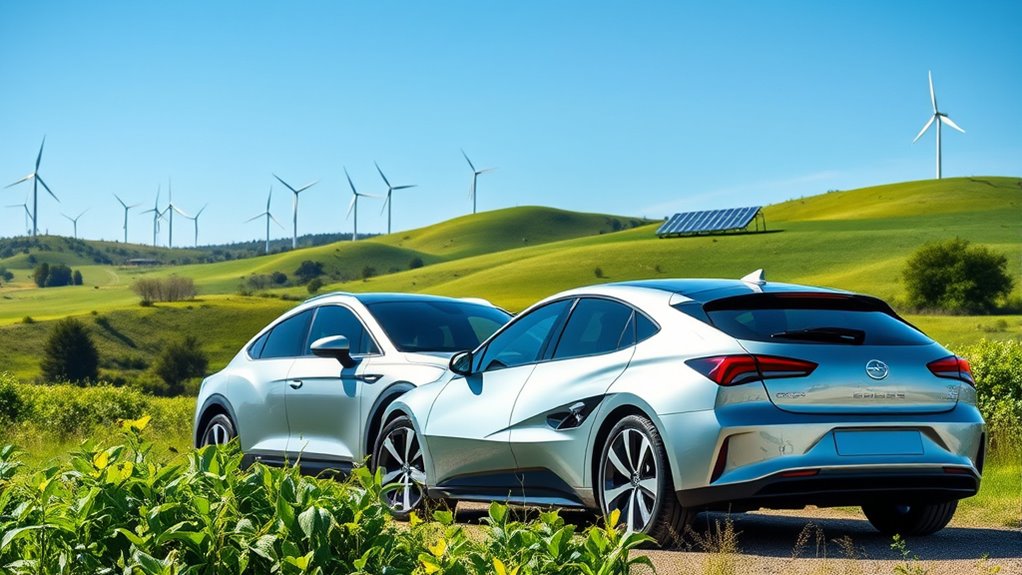
When comparing the environmental impacts of hydrogen technologies to traditional combustion engines, emissions profiles play a key role. Hydrogen fuel cell vehicles emit only water vapor and warm air, producing no harmful pollutants like nitrogen oxides, hydrocarbons, or particulate matter, making them much cleaner.
Hydrogen internal combustion engines emit fewer pollutants than gasoline or diesel engines but still generate some emissions. Conventional engines rely on fossil fuels, releasing significant greenhouse gases and pollutants that harm air quality and public health.
Fuel cells have no carbon footprint during operation, especially when hydrogen is produced from renewable sources. In contrast, most hydrogen today comes from fossil fuels, which increases environmental impact.
Shifting to renewable hydrogen production is essential to maximize the positive environmental benefits of hydrogen-powered transportation.
Fuel Quality Requirements and Infrastructure Compatibility
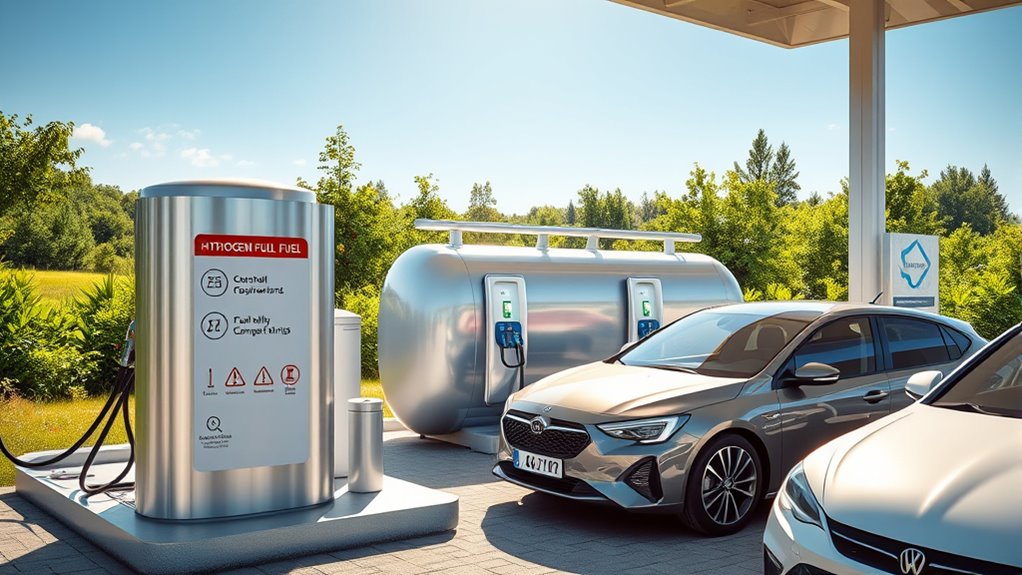
Ensuring fuel quality and infrastructure compatibility is essential for the effective deployment of hydrogen-powered vehicles. Fuel cell systems demand extremely high purity hydrogen, meeting standards like SAE J2719 or ISO 14687, with impurity levels in the low ppm range—especially for oxygen, carbon monoxide, and ammonia—to prevent catalyst poisoning and membrane degradation. Hydrogen used in fuel cells typically requires purity levels of at least 99.998%. Infrastructure must include specialized storage, purification, and monitoring systems to maintain this purity, requiring significant investment. The development of robust safety measures and real-time monitoring is crucial to prevent contamination and ensure consistent fuel quality. In contrast, hydrogen combustion engines are more tolerant of lower purity hydrogen, often sourced from existing industrial supply chains with fewer modifications. Their infrastructure can utilize conventional materials and delivery methods, reducing costs and complexity. This flexibility makes combustion engine hydrogen infrastructure easier to implement, while fuel cells necessitate stricter controls to ensure ideal performance.
Technological Maturity and Deployment Readiness

Fuel cell technology is advancing rapidly in transportation, evidenced by increasing patents and focused engineering efforts aimed at performance improvements. You can see this growth in the rising patent activity and ongoing durability testing, although challenges remain under real-world conditions. Additionally, the development of fuel cell stacks with higher power density and longer lifespans is crucial for widespread adoption. Fuel cell stacks with higher power density and longer lifespans Meanwhile, building energy supply scenarios show early-stage maturity, with limited media exposure and adoption. Core electrolysis reversal technology is proven for electricity generation, but scaling fuel cells faces hurdles like high-cost materials and limited manufacturing infrastructure. Transparency in affiliate relationships safety protocols are standardized for hydrogen handling, yet mass production remains constrained. Public-private partnerships are accelerating pilot projects, especially in heavy transport sectors.
Suitability for Different Applications and Operational Performance

Hydrogen fuel cells and combustion engines each excel in different operational contexts due to their distinct efficiencies and emission profiles. Fuel cells convert chemical energy directly into electricity, achieving 40-60% efficiency, making them ideal for long-distance and heavy-duty applications that need sustained power. They emit only water vapor, perfect for urban transit and indoor use.
In contrast, hydrogen combustion engines have lower efficiencies of 20-30%, but they handle high load conditions well, suited for heavy-duty vehicles hauling large loads. They can operate without complex systems but produce trace CO₂ and NOx emissions, limiting their indoor or confined space use.
Fuel cells offer smooth, quiet operation with fewer moving parts, while combustion engines benefit from established technology and simpler fuel handling, influencing their suitability for various operational demands.
Contributions to a Sustainable and Green Economy
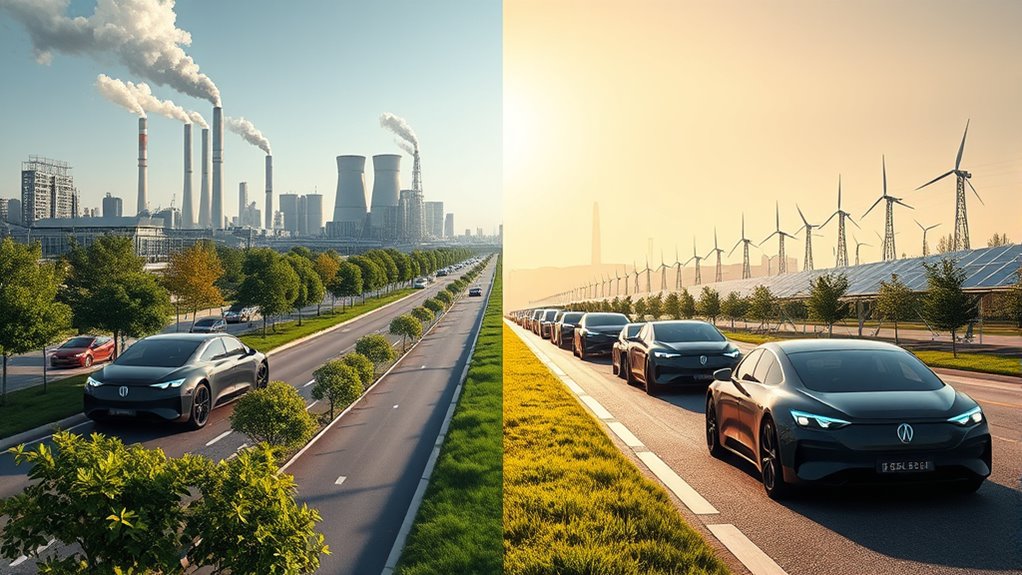
Hydrogen-powered technologies contribute considerably to building a sustainable and green economy by offering cleaner alternatives to traditional fossil fuels. When burned, hydrogen produces only water vapor, drastically reducing greenhouse gas emissions. If produced from renewable energy, hydrogen’s lifecycle emissions are near zero, supporting climate change mitigation. Hydrogen can be produced through electrolysis using renewable electricity, making it a truly clean fuel option. In transportation, hydrogen can lower carbon dioxide emissions, especially in sectors where electrification is challenging. Beyond emissions, hydrogen improves air quality by emitting no nitrogen oxides or particulate matter, benefiting public health. It also diversifies energy sources, enhancing security, and can adapt existing infrastructure to reduce transition costs. Additionally, hydrogen helps decarbonize heavy industries, long-distance transport, and chemical processes. Recognizing the importance of energy diversification can further accelerate the adoption of hydrogen technologies and reinforce a resilient energy system.
Future Perspectives and Strategic Integration of Hydrogen Solutions

As advancements in technology continue, the future of hydrogen fuel cells looks promising, with significant potential to transform energy systems. You’ll see costs decrease as innovations make fuel cells more competitive with traditional sources. Their high energy density makes them ideal for long-distance transport and heavy-duty applications.
When powered by green hydrogen, fuel cells produce only water vapor and heat, supporting a sustainable economy. They’re scalable for small vehicles and industrial use, with improved durability that reduces maintenance.
Meanwhile, hydrogen combustion engines face challenges like embrittlement and lower efficiency, but they benefit from existing infrastructure and lower conversion costs. Strategic integration involves deploying fuel cells in transport and energy storage, while combustion engines can serve as transitional solutions, especially with hybrid systems.
Both options will shape a versatile, resilient hydrogen economy.
Additionally, ongoing foraging research into plant ecosystems and sustainable harvesting techniques provides valuable insights that can inform environmentally friendly practices in energy development and resource management.
Frequently Asked Questions
What Are the Safety Considerations for Hydrogen Storage in Vehicles?
When considering hydrogen storage in vehicles, safety is key. You should guarantee tanks are designed to withstand high pressure, temperature, and cycling, meeting strict federal standards like FMVSS 308.
Incorporate leak detection sensors, safety valves, and robust materials to prevent leaks and explosions. Proper venting systems and crashworthiness tests are essential.
Regular maintenance, prompt leak detection, and adherence to safety regulations help you minimize risks of fire or hazardous leaks.
How Does Hydrogen Infrastructure Development Impact Overall Transportation Costs?
Imagine building a highway through a rugged mountain terrain—every mile of infrastructure shapes your journey’s cost. When you develop hydrogen infrastructure, costs fluctuate like winding roads.
Pipelines cut expenses by over half, but new builds can drain resources. Scaling up with existing pipelines, liquefaction, or chemical carriers lowers costs, making transportation smoother and more affordable.
Your investment in infrastructure directly paves the way for cheaper, cleaner travel.
Can Hydrogen Combustion Engines Operate Efficiently With Renewable Hydrogen?
You might wonder if hydrogen combustion engines can run efficiently with renewable hydrogen. The answer is yes; they operate at about 40% efficiency, which is lower than fuel cells but still markedly better than gasoline engines.
Using renewable hydrogen makes these engines environmentally friendly, emitting only water vapor.
With advancements in engine design and combustion control, you can expect stable, effective performance, supporting a cleaner, sustainable transportation future.
What Are the Long-Term Maintenance Differences Between Fuel Cells and Combustion Engines?
You want to know how maintenance differs long-term between fuel cells and combustion engines. Fuel cells require less frequent, simpler maintenance, mainly inspecting stacks, filters, and moisture levels, thanks to fewer moving parts.
In contrast, combustion engines demand regular oil changes, component replacements, and deal with carbon buildup.
Over time, fuel cells tend to be more reliable and cost-effective, while combustion engines incur higher maintenance costs and more frequent repairs.
How Do Regulatory Policies Influence the Adoption of Hydrogen Technologies?
Regulatory policies shape how quickly you can adopt hydrogen technologies by setting safety standards, offering incentives, and streamlining certification processes.
You benefit from federal subsidies and clear standards that reduce risks and build trust in hydrogen solutions. However, fragmented regulations across different levels can cause delays and increase costs.
When policies are harmonized and transparent, they make it easier for you to invest in and deploy hydrogen infrastructure and technology.
Conclusion
As you explore hydrogen technologies, remember that fuel cells convert energy with up to 60% efficiency, outperforming combustion engines at around 25-30%. This means you can generate more power with less hydrogen, reducing emissions and resource use. Embracing advanced fuel cell systems can accelerate your contribution to a greener economy. By choosing efficient, clean solutions now, you’re helping pave the way for a sustainable future where hydrogen plays a pivotal role.
